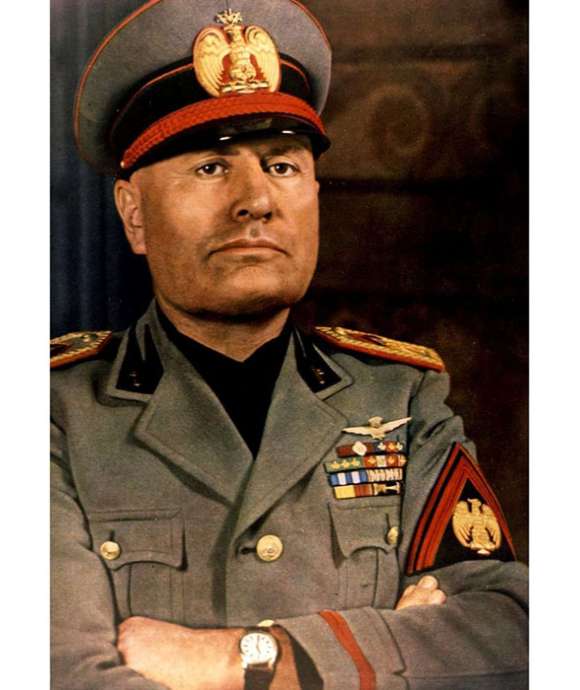How Did Hitler Die?
As Soviet soldiers scoured the burning streets of Berlin above his head searching for him, on April 30, 1945 Adolf Hitler began his normal work routine that morning deep in the bunker under the Reich Chancellery building. Ten days before, he had emerged from the bunker into daylight on his birthday. He inspected, with a trembling hand, a group of boys sent to defend the city against the Red Army in the name of Hitler’s professed philosophy of racial superiority.
On the April 29, he had completed his will and last political testament, and married his longtime mistress, Eva Braun. Word that Benito Mussolini had met his death in Italy arrived before lunchtime; Mussolini’s corpse, along that of his mistress, Clara Petacci, had been smashed in fury by a mob and hung upside down outside a gas station—a most ignoble end for the man whom Hitler credited with having taught him that a civilization’s decline could be reversed.

Death of the Duce, Benito Mussolini
The death of Benito Mussolini on April 28, 1945 was characterized “A fitting end to a wretched life,” by The New York Times.
The tee-totaling, vegetarian Hitler had a quiet last lunch, shook hands with the remaining staff, and that afternoon committed suicide with his wife on a couch in his private sitting room. Winston Churchill would later write,
“The bodies were burnt in the courtyard, and Hitler’s funeral pyre, with the din of the Russian guns growing ever louder, made a lurid end of the Third Reich.”
Winston Churchill

Detail of Hitler's underground bunker from the sign in the parking lot today
Courtesy Keith Huxen, PhD
The Fuhrerbunker Today
A Museum tour in 2017 visited the Fuhrer bunker in Berlin, site of Hitler’s final demise. Although all our guests knew what to expect of the site, a visit to the apartment parking lot that covers the underground bunker today, marked for memory only by a somewhat shabby metal frame and plastic covered historical sign explaining the significance of the place one is standing, and what is underneath your feet, remains a somewhat unsettling experience for anyone with a historical mind or moral conscience.
But it is fitting.
My most memorable part of the experience of visiting the site is recalling the reactions of two of our guests, both men in their 90s, both veterans who served in World War II, but not in Europe. I knew that one man had been to the site several times before when doing business in Berlin over the years, but was still a little surprised when he decided to stay at the hotel.
When we talked about the day later that evening at dinner, I asked him if he had any thoughts about the site from his previous visits. He just smiled and turned our conversation to Mommsen’s History of Rome, which I understood to be his poetic way of implying that everything passes. While under quarantine, I was recently saddened to learn that he passed away.
I did not know if the other man had ever visited the Fuhrer bunker before, but at the site I watched as he walked around the parking lot and perimeter of the site, alone in his thoughts. I did not want to intrude, and never asked him about what he was thinking. But because I have gotten to know him well over the years, it seems likely that he was thinking of the other young men he had served with, and fought with, during the war. He may have been thinking about the graves of friends in other parts of the world, or of the graves of so many unknown millions who perished because of this one man, Adolf Hitler.
Now three quarters of a century after 1945, I like to think of him as a young Marine back then, and then standing at that site in 2017 where beneath his feet Adolf Hitler’s wicked, murderous, evil life finally ended; and after many decades of working to make the world a better place, he stood in the sunlight as an old man, with a greater nobility and honor than any memorial can ever bestow.

Adolf Hitler's Fuhrer bunker lies under this parking lot in Berlin today
Courtesy Keith Huxen, PhD
After the war, even though the bunker was underground and the Reich Chancellery building was destroyed, the death place of Adolf Hitler threatened to become a pilgrimage site for modern neo-Nazis and others dedicated to the Nazis’ odious, racist, and genocidal political ideas.
The bunker was eventually filled in, and the German government would obviously not allow any graceful stone memorial, statue or plaque on the site. However, given Hitler’s legacy and the need for future generations to never forget what had been done in his name, it would seem an insult to history not to find some way to mark and remember what happened on the site. After all, it was, in a sense, the scene of the Allies’ ultimate triumph over Hitlerism.
Keith Huxen
Keith is the former Senior Director of Research and History in the Institute for the Study of War and Democracy at The National WWII Museum.
Cite this article:
MLA Citation:
APA Citation:
Chicago Style Citation:




![Max Fuchs, New York City cantor, sings as Rabbi Sydney [sic] Lefkowitz, Richmond, VA, conducts the first Jewish services from Germany.](/sites/default/files/styles/max_650x650/public/2025-10/image1.jpg)



